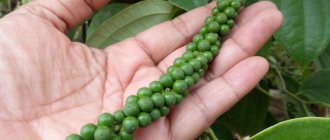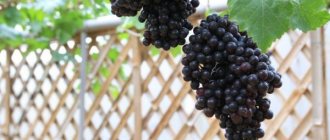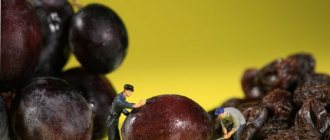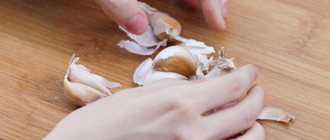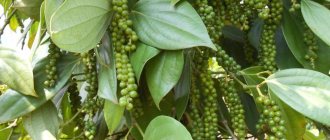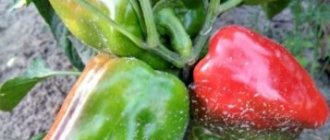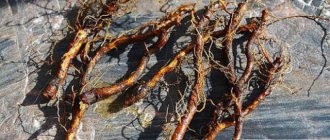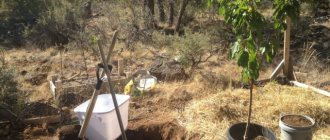Advantages and disadvantages
Pros:
- Early fruiting period.
- High yields.
- Good resistance to most diseases.
- Excellent appearance and interesting taste.
- Frost resistance.
- High plant survival rate.
- Easy to care for.
- Does not require additional pollination.
- The versatility of the fruit.
Minuses:
- Shedding of berries on the bush when overripe.
- Relatively small cluster size.
Origin
The photo shows the “parents” of the hybrid, produced in the USA, about which only positive reviews from winegrowers are known.
Parents of “Jupiter” – V. vinifera and vitis-labrusca
The first sample of the “Jupiter” grape was bred at the University of Arkansas, USA, by American scientists John R. Clark, James N. Moore in 1984. The “parents” of the new creation were “V. labrusca" and "V. vinifera". Since 1985, long-term testing of this variety began in a vineyard located in Tennessee. “Jupiter” was officially patented by the university only in 1998, and since then it has begun to spread throughout the world, winning the hearts of professional and amateur winegrowers. Since 2000, this variety has become popular in Russia.
Reference! D.R. Clark insisted that “Jupiter” was intended only to grow in the United States: the scientist did not consider his “brainchild” so successful that it could be presented to the world without fear.
Main characteristics
“Jupiter” is a universal black variety that is ideal for fresh consumption and can also be used as an ingredient for desserts, raw materials or for making wine. Drying this variety will give high-quality raisins that look quite presentable.
Ripening period
American grapes ripen in 110–125 days, which gives grounds to classify them as varieties with early ripening.
Bush
Abundant harvest of “Jupiter”
The bush is considered medium-sized; its peculiarity is that it practically does not grow in width. The recommended shape for it is a two-armed cordon or a four-armed fan. You can learn how to properly form a bush from a separate article.
The vine of the plant is reddish-brown in color, the leaves are large, painted in a lush green color, with 3 lobes and weak dissection. This colorful appearance of the bush attracts the attention of landscape designers, and the variety is often used for landscaping land plots.
The flowers of “Jupiter” are bisexual, the variety does not require additional pollination.
Bunches and berries
The bunches are relatively small in size, their weight on average varies between 250 - 500g. The fruits have a presentable appearance: a cone-cylindrical shape of medium density and may have “wings” of moderate size.
But the real decorative luster of the grapes is given by the berries: large, weighing from 5 to 7 g, oblong-oval in shape and with a pointed tip. They, adjacent to one hand, can simultaneously have different colors depending on the stage of maturation: greenish-pink, deep pink, red and dark blue.
The pulp is juicy, dense, crispy. “Jupiter” is considered a sultana variety, so there are no seeds inside the pulp. Sometimes you can find rudiments in individual grapes, but they are very soft and do not spoil the taste. The skin is thin, easy to chew, but at the same time not subject to cracking on the bush and during transportation.
The berries are characterized by good sugar accumulation - up to 22% with an acidity level of 4 - 6 g/l.
Jupiter berries and 5 kopecks
Taste
“Jupiter” has a subtle isabelle tone with obvious notes of nutmeg and strawberry.
Description of the variety
Kishmish Jupiter belongs to the early grape varieties (the berries fully ripen 115–125 days from the beginning of the growing season). To ripen, grapes require a total heat intensity of 2400–2600˚C. The bushes reach medium sizes. The vines have a good ability to ripen (90–95% ripen by autumn).
The flowers of the Jupiter grape are self-pollinating, bisexual.
Jupiter flowers are bisexual and do not require other pollinators
Of the total number of shoots, about 75% are fruitful. Fruitful shoots most often form from replacement buds. Shoots from replacement buds are mostly fruitful. The leaves are not very large, bright green, with a smooth surface (without pubescence).
The leaves are not large in size and have a smooth, glossy surface.
On each fruitful shoot, 1–2 clusters are formed, having a short stem and medium size (weight 200–250 g).
By the beginning of June, Jupiter's ovaries begin to fill
Cylindroconical clusters have a loose structure and are formed from large (4–5 g) oval berries. The color of the berries changes during ripening from reddish to dark blue. In very hot weather, coloring of the berries may occur before the pulp ripens.
When the berries ripen, the color of the skin turns reddish-blue
The thin but durable skin covers a very juicy, fleshy pulp with a pleasant taste and a light nutmeg aroma. Muscat tones become brighter if you leave the berries on the bush. Despite the high seedlessness of the variety, small soft rudiments of seeds may be found in the berries. The sweetness of the taste is explained by the high sugar content (about 2.1 g per 100 g) and not a very high concentration of acids (5–7 g/l).
Growing Jupiter grapes in Poltava region - video
Comparison with analogues
Another variety of black grapes called “black finger” or “black finger” also does not contain seeds. It comes from Israel, and is therefore recommended for cultivation only in warm latitudes. Frosts of -20ºС are destructive for it, which cannot be said about the “Jupiter” variety. But the weight of the brush and berries of the “black finger” is superior to the “American”: 1 kg and 12 - 14 g, respectively. The taste characteristics of the heat-loving variety are also at a high level.
Another seedless variety bred in the USA is “Kishmish Century”. It is superior to “Jupiter” in terms of fruit size (a cluster can weigh up to 1.4 kg) and low vulnerability to most fungal diseases. But “Jupiter” is sweeter (Kishmish Century has a sugar content of 13%) and is more frost-resistant (-29ºС versus -23ºС). It is also worth noting such varieties as “early gourmand” and “radiant raisins”.
Reproduction methods
The plant takes root and takes root well. Jupiter can be propagated:
Rooted cuttings or grafted seedlings
Rooting grape cuttings
This propagation method is good because the bushes completely inherit all the technical characteristics of the variety. And grafted specimens are distinguished by the most powerful growth force.
By grafting onto the rootstock
According to the opinions of experienced winegrowers, the Jupiter variety is excellently compatible with the Kober 5BB, C04 and Berlandieri XRiparia grape rootstocks.
Layerings from the mother bush
Laying grape cuttings for propagation
In this case, you need to use a fruit-bearing grape bush with strong, well-ripened vines, which will serve as material for propagating the grape crop.
Features of cultivation
“Jupiter” is grown both on an industrial scale and at home, thanks to the ability not to cover it for the winter.
Landing
The best time to plant young seedlings is spring. Over the summer, they will have time to get stronger and gain strength, and successfully adapt to environmental conditions. As a last resort, you can plant the plant in the fall, but then you must provide it with the most reliable protection from bad weather and low temperatures.
Place and soil
For the “American”, a sunny, wind-protected place is suitable. It does not accept planting near fences and trees, or stagnant moisture, but loose and fertile soil is what is needed. “Jupiter” is not picky when it comes to preferring a certain type of soil.
The hole for the bush should be dug no later than 2 weeks from the expected planting date; it would not be superfluous to fill it to half the depth with a nutritious mixture of compost and phosphorus-potassium fertilizers. The recommended distance between bushes is 2 – 4 m.
Watering and fertilizing
Regular watering is the key to a future harvest. Experts recommend that in case of systematic precipitation, water the plant only 2-3 times per season: during budding, filling of ovaries and after harvesting.
If dry and hot weather dominates, then it is necessary to add 15 liters of water under each bush every 3 days. However, 2 weeks before the expected harvest date, watering should be stopped. To preserve moisture, it would be good to mulch the soil surface with rotted manure or compost, sawdust, peat, or simply mown grass. The ideal option is drip irrigation.
Another integral component of a good harvest is feeding the plant. You should not overfeed the bushes, but the grapes should still receive a minimum set of fertilizers: in the spring - nitrogen-containing fertilizers, 2-3 times during the summer - potassium sulfate and monophosphate, magnesium sulfate.
Trimming
The shape of the bush must be maintained with annual pruning. In autumn, all shoots must be shortened by 6 - 8 buds, leaving about 40 shoots on the bush. Fruitless vines must be destroyed.
After winter, the plant is also thinned out: all dead, damaged, weak shoots are removed.
Diseases and pests
“Jupiter” is considered a resistant variety to oidium and mildew, as well as gray rot. But prevention should not be neglected: treatment with biological products against fungal diseases still needs to be carried out 1–2 times per season.
Grape growers also recommend using Bordeaux mixture or popular fungicides. They process the grapes 2 times before flowering and 1 time after it. But the last treatment before wintering should be done with iron sulfate.
To avoid damage by aphids, mites and leaf rollers, plants must be regularly inspected, removing damaged parts, loosening the soil around the trunks, and fighting weeds. If a case of infection is still recorded, then the bush must be immediately treated with insecticides.
You should be wary of the “Jupiter” of birds and wasps. Measures to combat them are classic. A stretched net, covers for the grapes, arranged sweet baits with poison, rattles, foil ribbons.
Wintering
“Jupiter” is frost-resistant: it can survive temperatures dropping to -29ºС. This makes it possible to grow the plant even in regions of risky farming. In southern latitudes, such frosts are very rare, so winegrowers never cover the vines of this variety for the winter. But in northern latitudes it is still worth insulating the plant. A similar procedure is usually carried out: the lashes are removed from the support, bent to the ground, tied and covered with spruce branches, dry leaves, you can cover them with 10 - 15 centimeters of earth.
Reference! A distinctive feature of this variety is the restoration of frozen shoots during the coming season. There is no need to uproot such a plant; the regeneration process will take place quickly.
Harvest storage
“Jupiter” is a crop with good yield. From 1 hectare, up to 200 centners of berries are usually collected, and with properly organized care - up to 260 centners.
The grapes have good shelf life and transportability. At temperatures from 0 to +3ºС and air humidity of 90 - 95%, there is every chance for the bunches to “survive” until December - January.
The thick skin allows the fruit to maintain excellent presentation, so they can be transported over long distances without fear.
Regions
The geography of cultivation of the Jupiter variety is extensive. It can be grown both in the south of Russia and in the northern regions, in the Urals and Siberia.
Planting grapes
Growing grapes begins with planting. But even before that, you need to choose a suitable place for it on the site. Jupiter grapes can ripen only with plenty of sunlight and a temperature of at least +24 degrees, so the planting location must be sunny. It is advisable to choose a southern slope or hill. You can plant grapes on the plain, but not in the lowlands, where water accumulates after watering, melting snow, and rain!
Planting time is the end of March. It is better not to plant this variety in the fall, as there is a high chance that the seedling will not have time to take root. But during spring planting, the bush will probably have time to take root, grow its root mass, and then it will not be afraid of winter frosts. It is advisable to purchase a seedling in a specialized store, from breeders or in a nursery. The soil for planting is mixed from simple garden soil, humus, wood ash and a mixture of superphosphate and potassium sulfate.
Important!
Many gardeners value grapes for their rapid establishment in a new place. Jupiter usually does not get sick at the beginning of growth and quickly builds up its root mass.
Planting time: end of March
If several bushes are planted, a distance of 1.5 meters is made between them, and the row spacing is 2.5-3 meters. To get healthy, strong bushes, it is best to simply plant seedlings in holes, although sometimes bushes are propagated by grafting. The grafting is carried out in a split onto the rootstock Berlandieri X Riparia or Delight. If you still choose the method of conventional planting of a seedling, then you need to follow the rules so that the bush takes root quickly.
The hole for planting the seedling is made several days before the procedure. It should be approximately 50x50 cm in size if the seedling has a developed root. A day before planting, the root of the seedling is immersed in water. You can add a growth stimulator to it, Epin, for example. Drainage is poured at the bottom (broken brick, pebbles, crushed stone are suitable). Land for planting is poured into a hill on top of the drainage, and a seedling is placed on it. Its roots are covered with earth on all sides, evenly.
Important!
If, when planting a seedling, there is no support (trellis) nearby, then you need to install a peg in the planting hole to tie up the bush.
After the bush has been planted, you need to tie it to a trellis along which it will climb, water the root zone and mulch the ground. Peat, straw, hay, moss or something similar is often used as mulch. Some gardeners purchase special, decorative mulch.
Reviews
A sapling of the same age as Jupiter overwintered without shelter for the winter at -30, although it was covered with snow; many other varieties could not withstand this. Evgeniy, Kirovograd region.
I don’t like sultana jupiter, I’ll remove it. The berries are very beautiful, but are prone to cracking and disease resistance is low. Alexander Petrovich, Dnepropetrovsk region, Nikopol
I was not affected by mildew after the outbreak in the vineyard. The taste is nutmeg, labrusca never appeared. Igor, Dnepr
To my taste, I have never tasted anything tastier than Jupiter made from grapes. Vladimir Alekseevich, Krivoy Rog
A very tasty and unpretentious variety. Valeria Viktorovna, Odessa
Kishmish "Jupiter" is grown for the following purposes
- Consume fresh. The fruits are juicy, sweet, with a nutmeg aroma, ideal for dessert.
- Produce wine. Wine from this grape variety is not yet produced in industrial quantities, however, homemade wine is very tasty and aromatic.
- Preparing raisins. When dried, Jupiter grapes do not crack, so the raisins look presentable.
The technology for producing raisins at home is as follows:
- the berries are washed
- spread in one even layer on a tray
- the tray is placed in the sun for several days
- the finished raisins are transferred to jars and lowered into the basement
